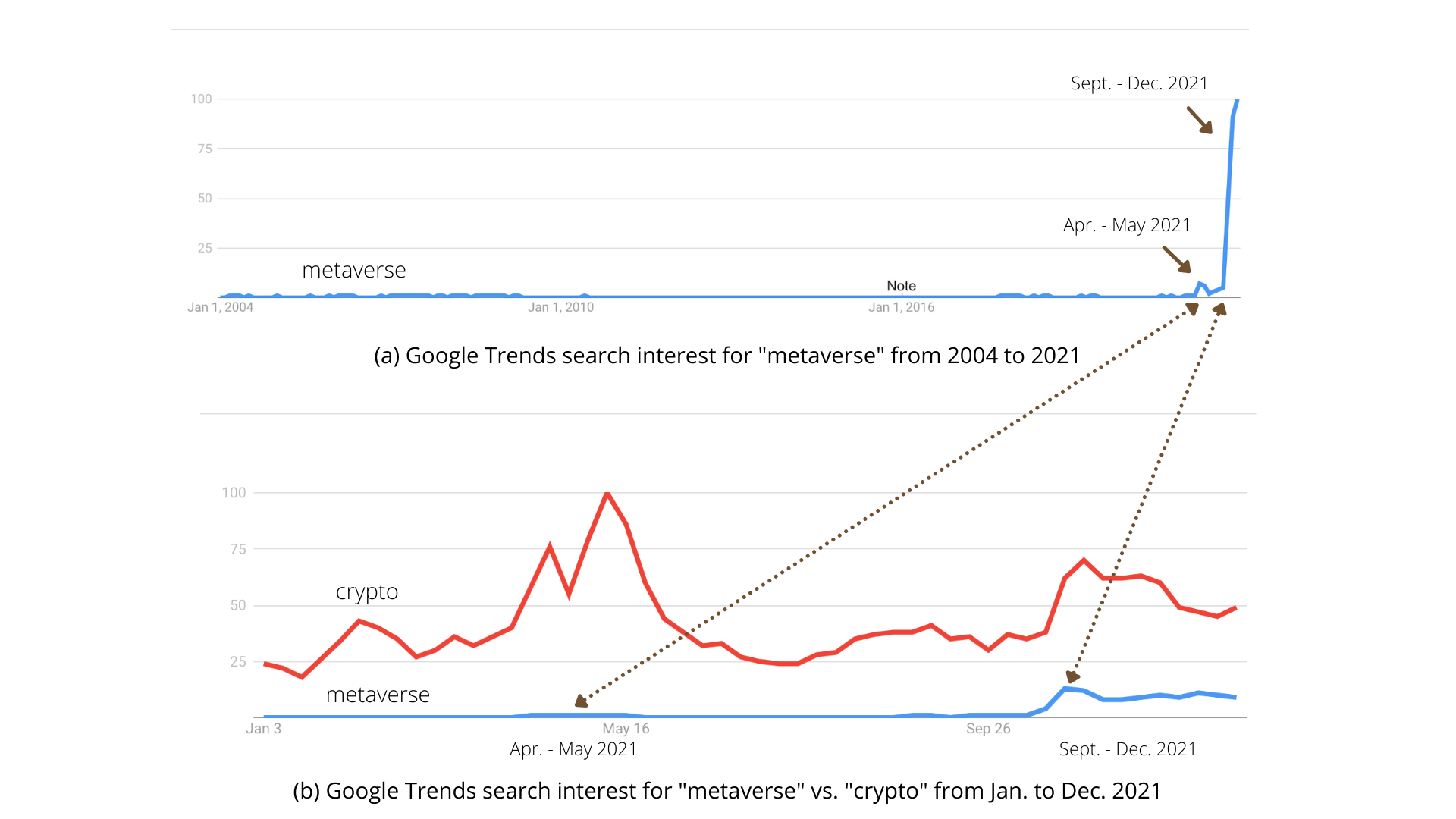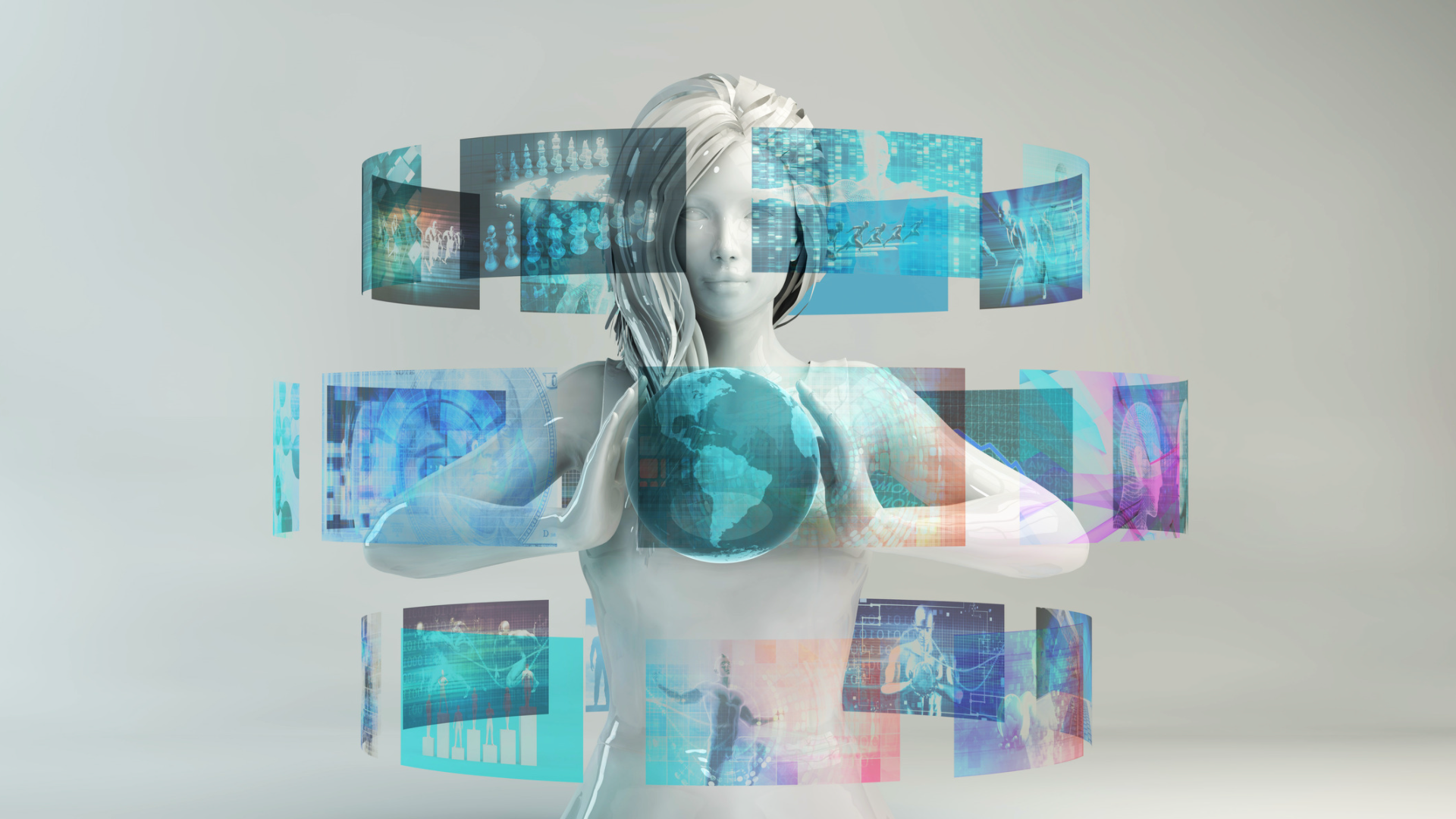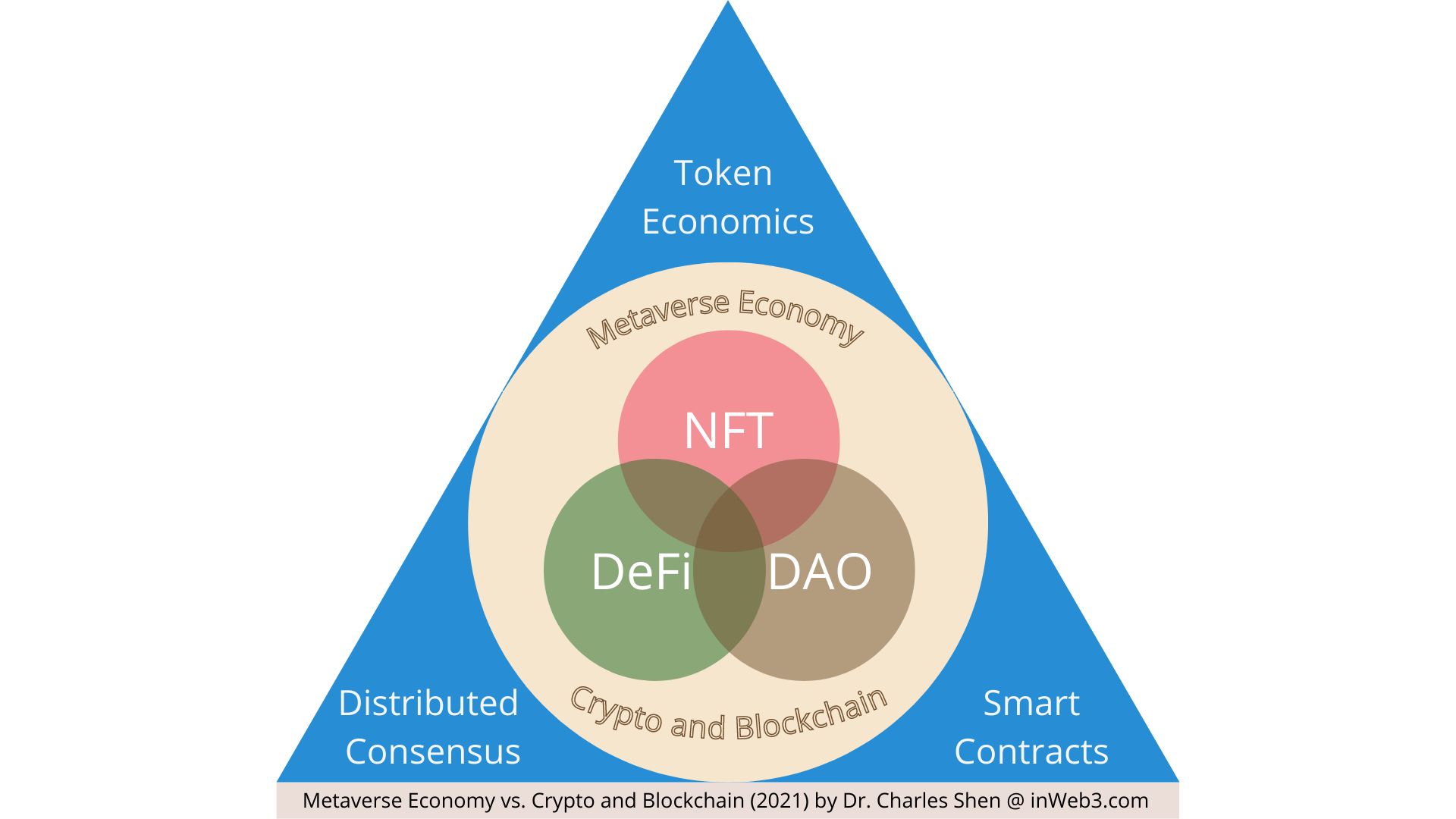What is the Metaverse and where are we in the journey?
We present the two critical aspects of a matured Metaverse: convergence of the physical and the virtual world, and a self-sustainable social-economic ecosystem. We also explain why we are at a milestone moment and how crypto and blockchain provide the foundation for the Metaverse economy.

"Metaverse" is undoubtedly one of the most hyped buzzwords as we enter 2022. Even though it was an old concept, the metaverse notion was rejuvenated in 2021 by several significant catalysts. Some of them point us to underpinning technologies that could considerably advance our path toward it.
This article discusses what essential impacts a full-fledged Metaverse will bring us, where we are in this journey, and why we are at a milestone moment for the Metaverse.
The incredible surge in interest for Metaverse
Figure 1 (a) shows the Google Trends worldwide search interest for "metaverse" since 2004. The amount has been largely negligible until 2021. We see the first notable bump in April and then an insane increase in the fourth quarter. If we zoom in to the year 2021 only and compare it with the search term "crypto", as in Figure 1 (b), we can find that the April bump for the "metaverse" search coincides with the peak search interest for "crypto" (which is actually "crypto"s historical all-time high search interest).

The incredible surge of "metaverse" search interest after October was associated with another search increase for "crypto". This time, the "crypto" peak search interest is roughly 70% of its peak earlier in the year, but the "metaverse" peak search interest actually sees an astounding 10+ fold expansion over its prior peak in April. This exuberant public sentiment over the "metaverse" is likely fueled by another factor: many bullish updates from dominant tech companies in the industry, especially Facebook. During the period leading to the end of October, Facebook announced that it is spending at least $10B on Metaverse over the year, plans to hire 10,000 in EU to build Metaverse, and even rebranded itself into "Meta".
These two catalysts, "crypto" and the tech industry's push for an immersive metaverse experience, correlate well with the two primary aspects of Metaverse development, as we will examine in the following sections.
So What is the Metaverse?
The most common definition of Metaverse is an online "virtual world" where people can "live," and it is considered an evolution from today's Internet. Neal Stephenson coined the word "metaverse" in his 1992 science fiction novel "Snow Crash." In his description, the Metaverse is a virtual reality (VR) online environment. People represented by their digital avatars can carry out various activities inside. Access to the Metaverse is via VR display goggles or public terminals. Some people even choose to wear portable VR goggles all the time so they can constantly be online in the Metaverse.
In the ensuing three decades, attempts to create such virtual world platforms have been abundant. The first well-known effort is Linden Lab's Second Life, released in 2003. It hits one million regular users in the early 2010s and is still used by many people today.

More recent examples of online virtual world platforms include Roblox and Fortnite. Both of them have accumulated millions of users. While they are typically considered gaming platforms, they can operate without specific gaming objectives. Users can create and share content (e.g., arts), host events (e.g., concerts), and conduct in-game monetary transactions (e.g., real estate or other assets) with others. In that regard, they are also a more general-purpose virtual world.
Does that mean the Metaverse has already arrived? The answer is not yet. But we can consider these examples as nascent forms of islands in the grand Metaverse. The question we want to ask ourselves is then, what does a fully developed Metaverse look like? What are its defining characteristics? Our answer to this question lies in the following two aspects:
- The Metaverse will bring a hybrid reality experience with the convergence of the physical and the virtual world
- The Metaverse will present a self-sustainable social-economic ecosystem
These two aspects are like the outer and inner parts of the Metaverse. As such, they are intertwined and advancing in parallel. Their progression speed may differ as influenced by the respective social and technological forces, but the eventual realization of the Metaverse depends on both of them reaching their maturity point.
Let us dive a bit deeper into each of these aspects.
The Metaverse will bring a hybrid reality experience with the convergence of the physical and the virtual world
We will have an immersive experience when interacting with the Metaverse, through Virtual Reality (VR) / Augmented Reality (AR) and related technologies. Virtual reality immerses the user into a digital environment that could be completely different from the user's physical surroundings. Augmented reality maintains the users' views of the physical settings and overlays the virtual environment on top of them. Meta (Facebook)'s CEO Zuckerberg is a top proponent of this vision and he recently wrote:
When I started Facebook, we mostly typed text on websites. When we got phones with cameras, the Internet became more visual and mobile. As connections got faster, video became a richer way to share experiences. We've gone from desktop to web to mobile; from text to photos to video. But this isn't the end of the line. The next platform will be even more immersive — an embodied internet where you're in the experience, not just looking at it. We call this the Metaverse. - Mark Zuckerberg (2021)
Today, a small group of early adopters can already enjoy exciting VR/AR experiences across different sectors. For example, in gaming, Roblox and numerous other games are already in VR; In tourism, VR can instantly teleport us to a remote historical site such as the Grand Pyramid for an immersive virtual tour; In commerce, retailers are providing AR-powered virtual try-on experience to allow consumers better test the product before they buy; In healthcare, surgeons use VR to digitally practice operations before performing on the actual patient; In workplace collaboration, Nivdia Omniverse, Facebook Horizons workroom, Microsoft Mesh are various platforms being developed that allow 3D workflow collaboration in different industries. The list goes on and on. However, today's VR/AR experiences are overall still limited, and only a niche of the population has access to them.

The situation will be vastly different as the Metaverse finally matures. At that time, the form factor, comfort level, and quality status of VR/AR goggles would have reached a point that we may not realize wearing these devices. The virtual environment they present to us is so realistic that we may not notice the difference between virtual and physical environments. Like Jon Radoff puts it - Metaverse is about the "de-materialization of physical space, distance, and objects." If we can have an authentic teleport experience to anywhere else instantly; if we can interact with the digital version of the world's objects the same way as we do with their local version, the physical distance and form factor no longer matters. That is when the boundary of the physical and the virtual world blurs, and when the door to the convergence of these two worlds opens for us.
Such a Metaverse will contain two main entity types: digital-only and digital-physical-twin entities. Digital-only entities exist just in the digital world. Digital-physical twins are virtual entities that have their real-world counterparts. There are several important attributes of these entities:
- For a digital-physical twin entity, either its digital or physical version may appear first. For example, when a person creates his avatar to engage in a virtual world, the physical form (person) exists before the digital format (avatar). On the other hand, if we create a 3D design model of a building and then construct it in real life, that would give the building a digital version before its physical format.
- The required level of twinness for the digital-physical twins varies for the applications. The highest degree of twinness would require the exact same state information between the two counterparts. If the state information is dynamic, it needs to be synchronized all the time. However, not all digital-physical twins have to have this level of accuracy. For example, suppose all we need is an avatar in the virtual world to represent Alice, who is talking to Bob's 2D cartoon avatar. Then another 2D cartoon avatar for Alice could work (even though not necessarily ideal). If we instead want to help Alice do a virtual try-on of clothes that she considers buying, we would better create an accurate 3D model of Alice to do the job.
- All entities in the Metaverse, whether digital-only or digital-physical twins, can have intelligence. They either possess intelligence naturally as human beings or can be powered by advanced AI for non-humans.
- The prevalence of intelligence among Metaverse entities has two important implications: First, since we can create as many intelligent digital-only entities as we like, we are essentially adding an infinite number of denizens into the Metaverse to live together with us! That is a profound difference when comparing the Metaverse with our physical world today. Second, even the line between humans and non-humans is getting obscured in the Metaverse. Typically, humans have a physical body and are represented by their digital twins. However, with the development of virtual beings who can interact like a human but are purely powered by AI and efforts that keep people alive in the virtual world even after their deaths, it becomes harder to tell who is actually a human and who is not in the Metaverse.
We have so far made tremendous strides in our journey towards a Metaverse that converges the physical and the virtual world. The 1990s saw the first release of widespread consumer VR headsets. In the 2010s, Palmer Luckey's team prototyped Oculus Rift and got acquired by Facebook for multi-billion dollars. Oculus is now a leader in the VR space and its app even won the title of the most popular app in the 2021 Christmas. Meanwhile, Microsoft has developed an AR headset Hololens that is used in different enterprise applications. Other major players such as Sony, Samsung, Nvidia are all very active in the VR/AR sector. Apple and Google also incorporated AR capabilities into their smartphone development kits to further facilitate AR applications.
However, despite all these achievements, the general usability of today's VR/AR goggles and related technologies has not reached a tipping point for imminent mainstream VR/AR adoption. The former chief architect for Second Life, Philip Rosedale expressed a similar tone in a recent interview. Therefore, while we have all reasons to be optimistic, we are yet to see that "iPhone moment" for the hybrid reality experience of the Metaverse.
The Metaverse will present a self-sustainable social-economic ecosystem
While most people tend to focus on the hybrid reality aspects of the Metaverse, its social-economic ecosystem aspect is equally, if not more, important. In fact, all of today's well-known online virtual world platforms allow users to create, earn, and transact virtual properties. The massive amount of these transactions already forms micro-economic systems around these platforms. For instance, Fortnite sold $1 billion worth of virtual goods in 2018 alone.
However, the development of a Metaverse economy on top of these existing platforms faces crucial problems:
- These existing virtual world platforms are siloed. Each has its independent microeconomic system that does not interoperate with others.
- They are centralized platforms because the company that owns the platform has ultimate control of all properties in the virtual world. Even if the user has "earned" or "bought" the items, s/he technically does not own them since the company always has the power to take them away if needed.
- The above problems 1 and 2 are correlated. Suppose the user could indeed own their virtual items, s/he could then bridge it out of the specific platform, which opens the possibility to interoperate with other systems.
The full-fledged Metaverse will not be a collection of isolated micro-economies. It needs to be an ecosystem that contains fully connected, distributed, and interoperable economies systems that can together scale to accommodate the explosive growth of potentially tens of billions of entities.
2021 turns out to be a game-changing year for Metaverse because this is the first time we have seen promising efforts toward a solution to the above problems. Specifically, "blockchain and crypto" technologies have the potential to unlock the interoperability of all the separated islands and provide a solid infrastructure for the social-economic system that the Metaverse will create.
Blockchain technologies provide the infrastructure for crypto applications
To illustrate why and how Crypto and Blockchain can be the foundation of the metaverse economy, let us examine the framework shown in Figure 3.

A blockchain network consists of many computer nodes through which people conduct transactions. The outer triangle in Figure 3 depicts the three pillars of a blockchain system identified in my earlier blockchain framework in 2018. They include Distributed Consensus, Smart Contracts, and Token Economics.
- Distributed Consensus helps maintain a distributed ledger on all the nodes with a unified and immutable record of all transactions that ever happened in the blockchain network. Such a system enables a decentralized mode of operations so that any parties in the network can conduct transactions without a centralized intermediary.
- Smart Contracts provide the mechanism to handle transactions, replacing the eliminated centralized intermediaries. They can automate the execution of transactions according to pre-defined conditions.
- Token Economics or tokenomics deals with the supply and demand of cryptocurrency circulations in the blockchain ecosystem. It plays a critical role both at the infrastructure level in securing the distributed consensus process and at the application level in supporting various use cases based on cryptocurrencies.
Combining these three pillars forms a robust decentralized economic infrastructure for endless possibilities of crypto-based applications. As a permissionless system, it allows anyone to participate with a self-sovereign identity. It is also an open-source and composable system. Developers can adapt existing crypto applications to create new ones, like adjusting legos to form different castles.
Core Crypto application categories - DeFi, NFT and DAO
In the inner circles of Figure 3, we have the three most prominent crypto application categories running on the blockchain infrastructure as of early 2022, namely: "DeFi," "NFT," and "DAO."
- DeFi or Decentralized Finance provides all kinds of crypto-based financial services without any central financial intermediary. Examples of these services include cryptocurrency exchanges, lending, and borrowing marketplaces, and synthetic instruments markets.
- NFT or Non-Fungible Token supplies a mechanism to prove ownership of unique assets in the entire blockchain system.
- DAO or Decentralized Autonomous Organization represents a new way of coordination for a decentralized community. In the absence of CEOs or managers as in traditional organizations, a DAO replaces community governance decision-making with crypto token-holder voting. It then leverages smart contracts to execute the voting results.
The combined scope of the three core application categories offers a solid system for property ownership, property transfer, and community governance, covering all the essential elements of a fully functional economy.
Blockchain and Crypto as the foundation of the Social-Economic Ecosystem in the Metaverse
Now we are ready to see why blockchain and crypto are the enablers for the Metaverse economy.
- First, with blockchain's self-sovereign digital identity and NFT-based property ownership, people can, for the first time, truly own their virtual properties in the Metaverse. This fundamental change paves the way for people to take their virtual assets out of the microeconomy of specific platforms, and transact them in the rest of the Metaverse. Thus, the Metaverse is no longer siloed and finally becomes a truly connected ecosystem.
- Second, the flexibility and openness of the blockchain infrastructure and its support for unlimited types of crypto applications provide the key to creating a self-sustainable social-economic ecosystem in the Metaverse.
- Third, crypto applications can bridge the fiat economy in the physical world. Through this bridging, the virtual and the physical world also gradually converge economically.
We have seen promising early cases in 2021 demonstrating the power of the Metaverse economy. Crypto-based game Axie Infinity is a notable example. The game allows players to own in-game properties using NFTs. The players can then take them out of the gaming world, use DeFi exchanges and crypto-fiat bridges to turn them into fiat currency, and even make a living on it. This phenomenon spearheaded the famous play-to-earn model. Decentraland and Sandbox are two other crypto-based virtual worlds where people can build properties, own assets, and monetize their virtual experiences. All these platforms are either already managed through DAO or are planning to switch to a DAO governance structure through their respective crypto tokens.
There are also metaverse economy activities by major brands that showcase the economic convergence aspect of the physical and the virtual world. Adidas is one of the latest examples. It sold more than $23 million worth of virtual goods in NFT in a single afternoon. In addition, it offers exclusive collaborative physical merchandise to these virtual goods NFT holders.
Overall, the Metaverse economy sits at the intersection of DeFi, NFT, and DAO, and introduces almost infinite possibilities. The development of the Metaverse economy will progress in parallel with the fiat economic system for a long time before they eventually converge in some way.
However, we believe that we have reached a milestone moment for the Metaverse economy by identifying the blockchain and crypto infrastructure as its underpinning technologies. It is now time for us to start the next leg, and build toward our full-blown Metaverse vision.
Summary
Metaverse is a concept that originated in 1992. It refers to an online virtual world where people can live and carry out activities as if they are in real life. 2021 saw an astronomical increase of public interest in the Metaverse never occurred in the past three decades. We examined the catalysts that led to this phenomenon. We further asked what a full-fledged Metaverse actually means for our lives. Our answer lies in two main aspects:
First, the Metaverse will bring a hybrid reality experience with the convergence of the physical and the virtual world. This aspect ties closely to VR/AR and related industries working on immersive experiences bridging the physical and the virtual environments. A signature industry event of the year is Facebook, which is both the leading social media network company and a top VR device maker, rebranding itself to "Meta". These activities fueled the historical all-time high public interest in Metaverse towards the end of 2021. Despite all the updates from tech companies and progresses made on VR/AR devices and applications, we think that we are still waiting for an "iPhone moment" to kick off the actual widespread adoption of VR/AR and to experience the convergence of the physical and the virtual world.
Second, the Metaverse will present a self-sustainable social-economic ecosystem. If we consider the hybrid reality convergence aspect as the external part of the Metaverse, this social-economic ecosystem is the internal part. To understand the underlying forces for the system, we introduced a blockchain-crypto framework. It contains the three pillars of a blockchain infrastructure: Distributed Consensus, Smart Contract, and Token Economics, as well as the core crypto application categories this infrastructure currently supports, including DeFi, NFT, and DAO. Drawing upon some recent examples, we explained the most significant breakthrough for Metaverse in 2021, which is witnessing the potential of the blockchain-crypto framework as the foundation to create a truly connected, massively scalable, and self-sustainable social-economic eco-system in the Metaverse.
The Metaverse with both of the above aspects fully developed will signal the true arrival of the Web 3.0 era. The next segment of our journey towards this vision starts now, and it could turn out to be a multi-generational opportunity akin to the Internet in the '90s. But there is one noteworthy difference between this cause and the Internet. That is, the Internet economy today is dominated by a few big tech companies; the Metaverse tomorrow offers the prospect of a genuinely inclusive social-economic ecosystem and one that promotes "generational wealth transfer favoring the upcoming generations, not the legacy world."
Note: this article is part of my Introduction to Blockchain, Crypto, Metaverse and Web3: Beyond the Hype. You may find the rest of the articles in the series here.

